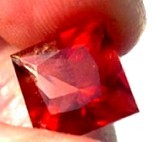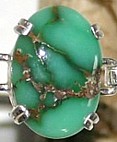
Treatment of Amethyst and Other Quartz Gems

 |
Treatment of Amethyst and Other Quartz Gems
|
 |
|
All the various forms of Quartz, including amethyst, citrine, and the cryptocrystalline forms such as agate, are among the most common of all gemstones. A huge variety of treatments from a radiation to heat to the use of dyes have been used to alter or colorize Quartz gems. Irradiation of Quartz containing iron can produce the well-known violet color of amethyst. At times irradiated Quartz crystals will show both the smoky and amethyst color. A careful heating to remove the smoky color without starting the loss of the purple amethyst color will improve the appearance of such a crystal. Significant heating of amethyst will produce a lightning of the color, eventually reducing the gem to a colorless state. Depending on the amount and form of iron present in the crystal upon heating and amethyst the purple may be lost and there may develop a strong yellow to orange color often called citrine. Nearly all citrine used in the jewelry trade is made by heating amethyst to about 450°C for a period of time. The stones are inspected periodically during heating process and removed when they reached the optimum color. Heating amethyst to a slightly higher temperature in the 500 to 575°C region intensifies the yellow color converting it to the deeper orange brown or reddish color of citrine sometimes called Madeira citrine. The conversion of amethyst into citrine often occurs at a slightly different temperatures even within a single crystal specimen, so the careful heating to about 350 to 400°C with material from some mines can produce a partial conversion to citrine in some parts of the crystal while other sections retained their original purple color. This results in a bicolor amethyst citrine sometimes called ametrine. Gems may be cut from ametrine which will display both the purple and orange yellow colors. In the amethyst from a few mines, the iron is present in the right portion of the crystal to produce a green colored gemstone on heating, which is sometimes called prasiolite. Production of the green color upon heating is very rare, but the citrine orange yellow is quite common. Amethyst which turns green comes from a location at Montezuma in Minas Gerais, Brazil as well as the four peaks area of Arizona. |
|
|
Irradiation of almost any colorless Quartz produces a smoky brown color which can range from black to gray and brown to reddish yellowish and even somewhat greenish tints. These colors are caused by a combination of different color centers which are produced by the irradiation. The dark brown gray color is suspected to be linked to the presence of aluminum and missing electron in the Quartz Crystal structure. Since nearly all natural Quartz contains some aluminum, nearly all colorless Quartz crystals will develop the smoky color upon irradiation. Heating these crystals can cause lightning and a change of color in smoky quartz crystals, sometimes too much more desirable shade. If enough heat is applied the stone be returned to fully colorless condition. One of the more desirable shades which may be achieved with a considerable portion of smoky quartz is a greenish yellow color, sometimes called neon citrine or honey Quartz. Typical temperatures range between 300 and 400°C. Occasionally, a blue color will be seen in treatment. Operators who conduct these treatments do them in ovens with a glass front so that the stones can be seen and removed when they reach the optimum coloration. The heating of certain agate materials is done to produce carnelian. It is also used to intensify the color of Tiger eye gems. The temperatures involved are normally about 500°C. The ancients used to heat Quartz and drop it into a cold liquid in order to produce fractures. Dyes were then used to color the gem through the use of these fractures. |
|
|
Want to know a little bit more about this crazy prospector guy? Well, here's a little bit more about me, and how I got into prospecting: Chris' Prospecting Story